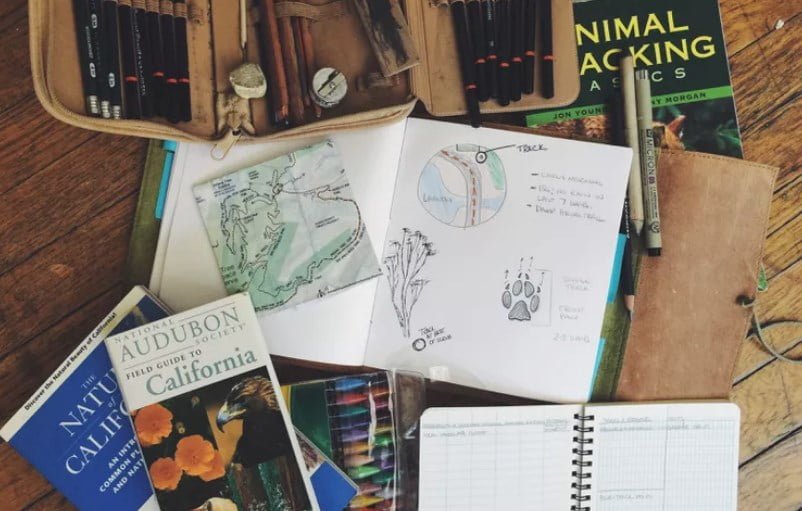Every explorer, scientist, and naturalist carries a notebook for jotting down observations, drawing sketches of species they’ve come across, outlining maps for newly explored areas or taking notes about seasonal changes.
A nature journal is a way to gain a better handle on your observation skills while allowing room to explore the excitement, wonder, and curiosity about what you’re seeing. Through its pages, you can get to know nature whether it is witnessed in your own backyard, a hiking trail, or a cross-country trek.

For students, the simple practice could provide the foundation for growing their conservationist mindset.
Teachers and parents can use nature journaling to help kids connect with the wilderness around them by finding interesting species of plants and animals in even the most urban environments. Children learn about the wildlife around them and gain skills in taking notes and noticing details like colors or behaviors.
But it isn’t just for kids. Nature journaling accomplishes a range of goals for adults as well, giving us a medium to focus our attention, engage our senses, encourage curiosity, and really see the wilderness that surrounds us at any moment.
The beauty of a nature journal is it is entirely up to the author how it looks and what is included.
You can make your journal a detailed description of a new plant or animal species you encountered, complete with drawings and notes on behaviors or notes with a scientific or exploratory angle. Or it can be a place to write your thoughts about what you’re seeing, hearing, and smelling during a hike. It can be a journal you keep specific to an area you frequently visit, or one you keep to connect with and better remember a new place. You can add sketches, colored drawings, watercolor paintings, photographs, measurements of animal tracks, or snippets from field guides.
There are no set guidelines, so be as detailed and creative as you like. The bigger goal is that you’re able to more keenly observe and connect to the wild outside.
So what do you need to get started on your own nature journal? Here are five basic steps that will get you on your way.
1. Decide What You’re Going to Journal About
Do you want to keep notes about your explorations during each hike or camping trip? Or do you want to journal only about a certain place (like your favorite nature preserve or even your own back yard) or about a certain species you see on a regular basis? Do you want to journal about in-depth observations as a citizen scientist, or do you want to journal thoughts about nature when inspiration strikes?
For instance, if you’re journaling to learn more about local species, you may want to bring a lined or grid journal as well as field guides with you. Or, if you’re journaling about the flora and fauna around you, consider drawing or painting what you see, and pack a sturdy sketchbook and a set of art supplies.
2. Gather the Materials You’ll Need
This includes a durable notebook (with lined or blank pages), a pen or pencil for note-taking, drawing supplies (colored or sketch pencils), perhaps a watercolor set, field books, and a small camera to photograph the plants and animals you want to remember and sketch later. Exactly what to include in your nature journaling kit can be honed as you figure out your needs.
3. Make a List of Questions to Ask
The first page of your journal can feature a list of questions to ask yourself so you remember to watch for details. Include reminders on the basics such as location, date, time, description of habitat, and weather. Then list out questions such as:
What types of animals do I see here?
What might these animals be eating? Where might they be nesting, burrowing, or resting?
What is the dominant type of vegetation?
How might the weather or time be affecting how the vegetation looks?
As I sketch a plant or animal species, what details do I notice about color, size, stage of life, or nearby species?
Are there signs of other species, such as droppings, tracks, flattened grass, or holes or remains of a meal?
How do I feel about where I am and what I’m seeing?
These and other prompts will help you be more detailed in the field, and soon you’ll notice more things and ask more in-depth questions. Take time to write as much as you can while in the field so you can fill out information based on observation rather than memory. And note any questions you have to look up in books or online when you get home.
4. Draw as Much as You Write
Drawing is a key part of nature journaling. Sketching out and coloring the species you’re observing can help you notice more details or ask more questions than you otherwise might. You can take photos for later reference if you want. Even if you think you aren’t much of an artist, as long as your sketches help you explore your subject and remind you of key details later, that’s all that really matters. They help you to create a record of what you’ve seen, and they can be informative and important regardless of if they’re art gallery-ready.
5. Look up Information When You Get Home
One last thing to remember about journaling: It doesn’t all have to happen in the field. Take notes and ask questions, then come home to look up answers or additional information. By the time you fill out the last page of your journal, you will have an extraordinary first-person record of not just what you’ve witnessed but also what you’ve learned along the way.


